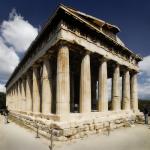|
This section contains 723 words (approx. 3 pages at 300 words per page) |

|
c. 390 B.C.E.–After 316 B.C.E.
Sculptor
Productive Career.
The sculptor Lysippus was born in Sicyon, a small city-state west of Corinth in Greece near the beginning of the fourth century B.C.E. He was active as early as 370 B.C.E., as an inscription found at Delphi makes clear, and according to another inscription, he made a portrait of King Seleucus, one of Alexander the Great's successors who laid claim to Alexander's conquests in the Near East in 312 B.C.E. He was extraordinarily productive. His workshop turned out literally hundreds of bronze statues. None survive, but a few copies sculpted in marble still exist. The most famous is his Apoxyomenos (Scraper) in the Vatican Museum, which portrays a naked athlete scraping himself. Athletes rubbed themselves down with olive oil before exercising and then, after exercise, scraped off the oil and sweat with a...
|
This section contains 723 words (approx. 3 pages at 300 words per page) |

|




